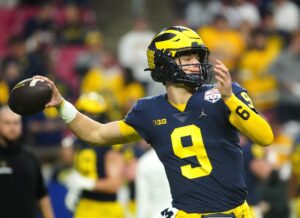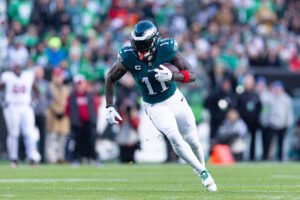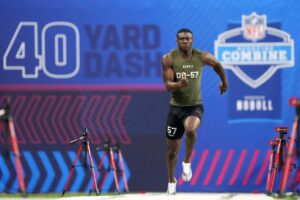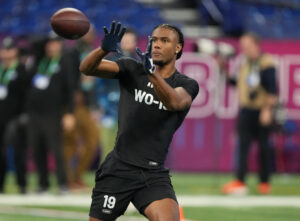With half of the 2019 regular season now in the books, several teams have begun separating themselves from the rest of the pack. At 7-1, the New Orleans Saints are certainly one of those teams.
Several formidable opponents stand between New Orleans and their Super Bowl dreams, But the Saints boast a key advantage over most of the NFL’s winningest teams; a suffocating run defense that’s forced opponents into a one-dimensional offensive approach over the last two seasons.
Here’s an in-depth look at just how dominant the Saints run defense has been.
New Orleans Saints Run Defense Consistently Dominant Over Last Two Seasons
Statistics
The Saints run defense began showing progress exactly two years ago. In the first half of 2017, New Orleans allowed a 5.0 or higher rushing average in three games. Since week nine of 2017, they have allowed two such performances (including postseason), the lowest figure in the league. Since the start of 2018, the Saints have also held opponents under 4.0 yards per carry in an NFL-leading 17 games.
Total production on the ground hasn’t been any easier against New Orleans. They’ve allowed fewer than 100 rushing yards in seven games during this same period, more than all but one other team. During that span, the Saints held opponents under 50 rushing yards in a league-best six games. No individual rusher has gained 100 or more yards against them since week 11 of 2017.
Overall, New Orleans has allowed a cumulative 3.71 yards per carry average since the 2018 season started, behind only the Chicago Bears. They’ve also allowed the third-fewest rushing yards during that span despite playing in more games than all but nine teams. Their 80.11 rushing yards allowed per game over this time period leads the NFL.
Some of these figures could be even better if not for a tough situation on the defensive line at the start of the 2019 season. Their top-three three-technique defensive tackles (Sheldon Rankins, David Onyemata, and Mario Edwards) all missed the season opener, which was one of the two games New Orleans allowed over 5.0 yards per carry. Rankins missed the first three games of the season, which made up three of the seven games since 2018 that New Orleans allowed over 100 yards rushing.
Comparison with Other Playoff Contenders
Since Rankins returned in week four, the Saints run defense has been better than ever, allowing a second-best 3.23 yards per carry during that span. They’ve also yielded a league-low 271 rushing yards, or 54.2 yards per game since week three. During this time period they’ve played three of the NFL’s 10 most productive rushing offenses: The Seattle Seahawks, Dallas Cowboys, and Jacksonville Jaguars.
Since week three, most of the NFL’s winningest teams have not fared well against the run. Of the 11 other teams currently slated to make the playoffs, only the Cowboys and Houston Texans rank 10th or better in rushing average allowed over the last six weeks. Six projected playoff teams rank in the bottom ten, with all of them allowing 4.6 yards per carry or worse during this span.
If New Orleans can maintain this excellence against the run, it will give them a big advantage over the other top teams going forward. There may be better overall defenses in the NFL, but right now no defense is forcing offenses into one-dimensional approaches better than the Saints. It helps that New Orleans has recently grown stronger against the pass as well.
Analytics
Opponent success rates on the ground further demonstrate how dominant the Saints run defense has been.
A successful play in the analytics world is defined as gaining 40% of the to-go yardage on first down, 60% of the remaining yardage on second down, or 100% of the needed yardage on third and fourth downs. By looking at first-half rushing success rates, you can get a clear picture of whether or not teams were able to establish a successful ground attack early on. This weeds out “garbage time” runs at the end of games when a team has a lead and is simply run out the clock.
This season, New Orleans has yielded a 35% success rate on first half runs, tied for the lowest rate allowed. Only three other teams have allowed a success rate under 40%. They’ve achieved this figure while playing against three offenses (Seahawks, Cowboys, Texans) that have top-10 success rates on first half runs.
Of course, a lot of rushing production comes on quarterback scrambles on passing plays. When including only success rates for first-half run plays by running backs, the Saints success rate allowed drops down to 32%. No other NFL team has allowed a rate lower than 36%.
Limiting Big Runs
Altogether, the Saints have yielded a league-low 492 yards to running backs this season. In week one, they allowed three runs of over 20 yards, but haven’t allowed any runs over 19 yards since then.
Part of this consistent success has to do with simply making tackles. New Orleans missed the sixth-fewest tackles of any team last season and so far have missed the seventh-fewest tackles in 2019.
While all these numbers paint a pretty clear picture, you have to take a look at the game tape to see just how effectively Saints defenders are containing runs.
Film Study
Let’s take a look at the Saints win over the Cowboys in week four, which is perhaps the Saints most impressive performance against the run over the last decade. New Orleans held running back Ezekiel Elliott to 35 yards and 1.94 yards per carry on 18 rushing attempts. This was Elliott’s second-lowest rushing average and third-lowest rushing yardage total recorded in his 50-games as a pro.
There’s no single factor that enables defenses to shut down one of the league’s top rushers. In this game, the Saints showed all the things a great run defense needs to be capable of.
Gang Tackling
It’s not easy for any defender to bring down a back like Elliott on their own. 6’6″, 265-pound defensive end Marcus Davenport proves this on a second-quarter Elliott run. Davenport makes a great diagnosis on a stunt and flies into the backfield untouched. However, Elliott shook off Davenport with a spin move and turned back upfield. He was then met by five different Saints defenders, who held Elliott to a three-yard gain.
Taking a look at the Saints run defense vs. Dallas. They did a great job gang tackling in this game.
Davenport makes initial contact on Elliott and can't quite hold on, but five other Saints defenders are there to finish the play. pic.twitter.com/p6EXPzHD92
— Ian (@HomesickWhoDat) November 5, 2019
Beating Double Teams
New Orleans found an upgrade at nose tackle in the off-season in signing four-year New England Patriots veteran Malcolm Brown. He’s done an excellent job of plugging up the middle this season whilst recording three tackles for losses. On this two-yard loss by Elliott, Brown initially gets sealed off on a combo block by the center and left guard.
Brown keeps powering forward though, and eventually, the center loses his angle and falls down. The right guard then had to move on to block A.J. Klein, allowing Brown to come free and make the tackle.
Malcolm Brown was a monster in this game. Here he fights off a double-team and drops Elliott for a 2yd loss. pic.twitter.com/7Ef3NxqqQ2
— Ian Riise (@IanLWOSSaints) November 5, 2019
Diagnosis
A few plays later, Brown makes another stop on a first and goal play with help from Onyemata. Lined up directly across from the center, Brown is tasked with defending both A-gaps. He pushes the center to the left, forcing Elliott back inside. When Brown sees Elliott cut, he sheds the blocker, and combines with Onyemata for the tackle.
A few plays later, Brown is tasked with defending two gaps two yards away from the goal line. His penetration forces Elliott straight ahead and he combines with Onyemata for the stop. pic.twitter.com/6l7rtbxsTD
— Ian Riise (@IanLWOSSaints) November 5, 2019
Both defensive linemen were put into a tough spot before the snap. Elliott switched over to Onyemata’s side, forcing Onyemata to slide over and cover the B-gap. While this was a necessary adjustment, it left the Saints vulnerable in the middle. If Brown and Onyemata hadn’t diagnosed Elliott’s run direction so quickly, he would have likely reached the end zone.
Adjusting on the Fly
After New Orleans contained Elliott through three quarters, Dallas attempted a reverse play to receiver Tavon Austin. If not for the efforts of Davenport and free safety Marcus Williams, the play would have resulted in a huge gain.
Reverses didn’t do the trick against New Orleans either. Davenport and Marcus Williams quickly read the misdirection and force Tavon Austin upfield early. This could’ve been a huge gain if not for their reactions. pic.twitter.com/VtIFBcpfwx
— Ian Riise (@IanLWOSSaints) November 5, 2019
Davenport reacted to the reverse quickly enough to stop his pursuit of Elliott and move back into an outside containment position. Quarterback Dak Prescott attempted to cut off Davenport, but couldn’t force him back inside.
Meanwhile, Williams read the reverse even before the ball switched hands and sprinted towards the right sideline. He got around a block and along with Davenport ensured that Austin couldn’t turn the corner.
Austin had to turn upfield early and got swallowed up by several defenders after a gain of three yards.
Pre-Snap Adjustments
Prior to Elliott’s final run of the game, Klein observed an audible by Prescott and realigned the Saints defensive line. He spoke to Brown, who moved into the A-gap on the right side, and he instructed Jordan to move outside the right tackle. Elliott’s run went to the left, but Jordan’s position prevented him from cutting back to the right after his blocks fell apart. Brown and Klein combined for the tackle and Elliott lost a yard on the play.
Klein makes an excellent pre-snap adjustment here. He instructs Brown and Jordan to slide right. The run goes to the left, but the adjustment put Jordan in good position to defend a cutback from Elliott. pic.twitter.com/yxblHyT9co
— Ian Riise (@IanLWOSSaints) November 5, 2019
Further Notes on Saints Run Defense
All of these things don’t come together after week without instilling a collective mindset among the entire defense. Defensive coordinator Dennis Allen and his staff have done an excellent job of doing just that.
Davis alluded to this mindest a couple weeks ago in response to a question about preventing “leaky yardage.” Davis said that coaches tell them to make sure that player isn’t still turned upfield towards the end zone when they hit them. This philosophy is visible on the field, as runners struggle to break tackles or gain yardage after contact.
Even the Saints defensive backs are embracing this mindset. Vonn Bell, Chauncey-Gardner-Johnson, and P.J. Williams among others have made impressive one-on-one tackles on running backs this year. These three players have made a combined seven tackles for losses in 2019.
Assuming the Saints reach the postseason, they will present a daunting matchup for any offense that leans heavily on their run game, and several of the NFC’s top-seeded teams currently fall under this category. Four of the six NFC teams currently slated to make the postseason rank among the top-10 most productive rushing offenses, including three in the top-five.
If the Saints defense can continue their recent progress in coverage, this unit will soon strike as much fear into Saints opponents as their star-studded offense.
Main Photo:
Embed from Getty Images






